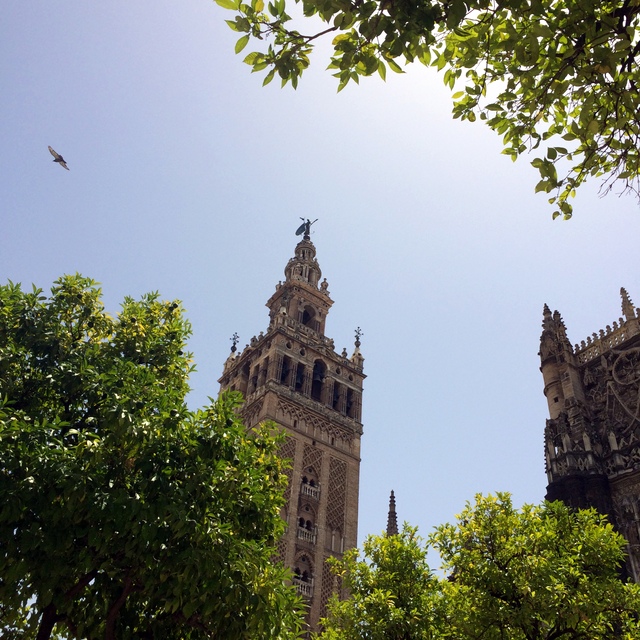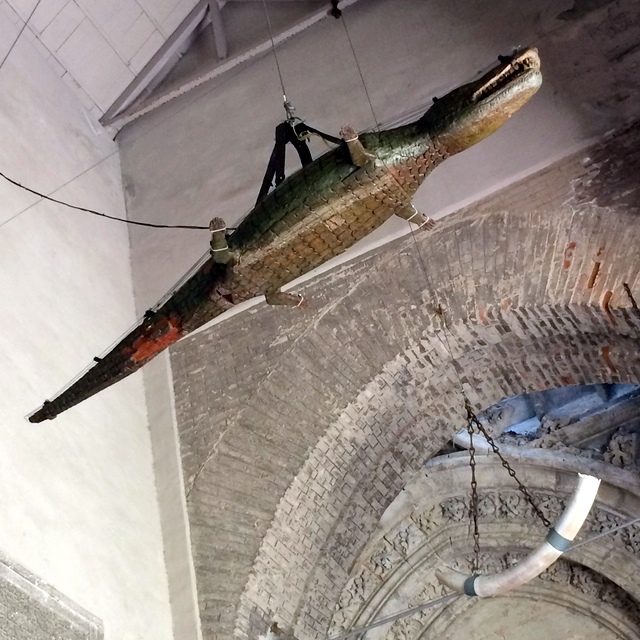This week we have another guest blog post by history buff, tour guide and long-time Seville resident Peter Tatford Seville Concierge. As usual, Peter has a story to tell.

It is only to be expected that a city as old as Seville, that at different times has had close connections with many other parts of the world, will have acquired its fair share of unusual objects. One such is the Lagarto, or lizard, actually a stuffed crocodile, which hangs from the ceiling in the corner of the Courtyard of the Oranges beside Seville Cathedral, and gives its name to the Gate of the Lizard, the old Moorish gate with the typical Visigothic horseshoe arch next to the Giralda Tower. Despite its size and location, it’s surprisingly easy to miss if you’re not looking for it. But when you do see it, the obvious question springs at once to the mind. “Why is there a crocodile just outside the Cathedral?” There is, of course, a story…
Once upon a time (in the Middle Ages) there was a king of Castile (the central region of Spain) called Alfonso X, also known as the Wise because of his love of learning, especially esoteric learning. His father, Ferdinand III, had conquered Seville from the Moors in 1248, and made it the capital of the kingdom, which Alfonso inherited in 1252.
Now, this being a once upon a time story, Alfonso had a beautiful daughter, named Berenguela. Actually, we don’t know if she was beautiful, but we do know she was illegitimate, so it’s as likely a reason as any for why the Emir of Egypt wished for her hand in marriage. To this end, the Emir sent a magnificent embassy to Seville with rich and exotic gifts for the king and princess. Among these gifts was a live crocodile, whose size astonished the Spanish. I’ve heard it said that the crocodile lived for many years and converted to Christianity, but a second version of the tale, that the crocodile languished in its captivity and shortly died, seems more likely. In either case, a wooden model of the beast was carved, and covered with its skin, and this was hung in the corner of the Courtyard of the Oranges, where it can still be seen today. And the Emir never got the girl.

Charming though the tale may be, there are those who see a deeper meaning in the crocodile. In ancient Egypt the crocodile God, whose name was Sobekh, was of great power, as a savant like Alfonso would certainly have known. He was important to the cycles of fertility and vegetation through his connection to the Nile, and devourer of the souls who failed to pass the judgement of Osiris after death. More importantly, he was able to protect against the evil eye, and the placing of a crocodile over the entrance to the cathedral was probably intended to help to keep the forces of evil at bay.
And there he has been ever since, through several earthquakes and the complete rebuilding of the cathedral in its modern form, a kitsch oddity and surprise for the eyes of children.
Right nearby are our Giralda Terrace apartments, three superb modern apartments in a fantastic location next to the cathedral.